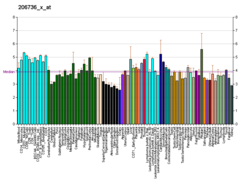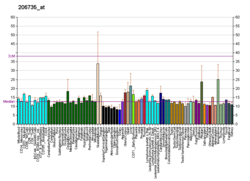CHRNA4
Neuronal acetylcholine receptor subunit alpha-4, also known as nAChRα4, is a protein that in humans is encoded by the CHRNA4 gene.[5][6] The protein encoded by this gene is a subunit of certain nicotinic acetylcholine receptors (nAChR). Alpha4-containing nAChRs (specifically the alpha4beta2 subtype) appear to play a crucial role in the addictive response to nicotine.
The nicotinic acetylcholine receptors (nAChRs) are members of a superfamily of ligand-gated ion channels that mediate fast signal transmission at synapses. After binding acetylcholine, these pentameric receptors respond by undergoing an extensive change in conformation that affects all subunits and leads to opening of an ion-conducting channel across the plasma membrane. The protein encoded by this gene is an integral membrane receptor subunit that can interact with either nAChR beta-2 or nAChR beta-4 to form a functional receptor.
Mutations in this gene appear to account for a small proportion of the cases of nocturnal frontal lobe epilepsy.[6] It has also been associated with a rare form of movement disorder characterised by dyskinesia during periods of exercise or activity called paroxysmal kinesogenic dyskinesia.[7]
Interactive pathway map
[edit]Click on genes, proteins and metabolites below to link to respective articles.[§ 1]
- ^ The interactive pathway map can be edited at WikiPathways: "NicotineDopaminergic_WP1602".
See also
[edit]References
[edit]- ^ a b c GRCh38: Ensembl release 89: ENSG00000101204 – Ensembl, May 2017
- ^ a b c GRCm38: Ensembl release 89: ENSMUSG00000027577 – Ensembl, May 2017
- ^ "Human PubMed Reference:". National Center for Biotechnology Information, U.S. National Library of Medicine.
- ^ "Mouse PubMed Reference:". National Center for Biotechnology Information, U.S. National Library of Medicine.
- ^ Anand R, Lindstrom J (Sep 1992). "Chromosomal localization of seven neuronal nicotinic acetylcholine receptor subunit genes in humans". Genomics. 13 (4): 962–7. doi:10.1016/0888-7543(92)90008-G. PMID 1505988.
- ^ a b "Entrez Gene: CHRNA4 cholinergic receptor, nicotinic, alpha 4".
- ^ Papandreou A, Danti FR, Spaull R, Leuzzi V, Mctague A, Kurian MA (February 2020). "The expanding spectrum of movement disorders in genetic epilepsies". Developmental Medicine and Child Neurology. 62 (2): 178–191. doi:10.1111/dmcn.14407. PMID 31784983. S2CID 208498567.
Further reading
[edit]- Skorupska E, Rózycka A, Trzeciak WH (2002). "[Molecular and genetic basis of idiopathic nocturnal frontal lobe epilepsy]". Neurol. Neurochir. Pol. 36 (3): 513–25. PMID 12185808.
- Pilz AJ, Willer E, Povey S, Abbott CM (1993). "The genes coding for phosphoenolpyruvate carboxykinase-1 (PCK1) and neuronal nicotinic acetylcholine receptor alpha 4 subunit (CHRNA4) map to human chromosome 20, extending the known region of homology with mouse chromosome 2". Ann. Hum. Genet. 56 (Pt 4): 289–93. doi:10.1111/j.1469-1809.1992.tb01155.x. PMID 1492743. S2CID 23586336.
- McLane KE, Wu XD, Conti-Tronconi BM (1990). "Identification of a brain acetylcholine receptor alpha subunit able to bind alpha-bungarotoxin". J. Biol. Chem. 265 (17): 9816–24. doi:10.1016/S0021-9258(19)38744-7. PMID 2351675.
- Steinlein OK, Mulley JC, Propping P, et al. (1995). "A missense mutation in the neuronal nicotinic acetylcholine receptor alpha 4 subunit is associated with autosomal dominant nocturnal frontal lobe epilepsy". Nat. Genet. 11 (2): 201–3. doi:10.1038/ng1095-201. PMID 7550350. S2CID 210163.
- Phillips HA, Scheffer IE, Berkovic SF, et al. (1995). "Localization of a gene for autosomal dominant nocturnal frontal lobe epilepsy to chromosome 20q 13.2". Nat. Genet. 10 (1): 117–8. doi:10.1038/ng0595-117. PMID 7647781. S2CID 12912669.
- Monteggia LM, Gopalakrishnan M, Touma E, et al. (1995). "Cloning and transient expression of genes encoding the human alpha 4 and beta 2 neuronal nicotinic acetylcholine receptor (nAChR) subunits". Gene. 155 (2): 189–93. doi:10.1016/0378-1119(94)00914-E. PMID 7721089.
- Steinlein O, Smigrodzki R, Lindstrom J, et al. (1995). "Refinement of the localization of the gene for neuronal nicotinic acetylcholine receptor alpha 4 subunit (CHRNA4) to human chromosome 20q13.2-q13.3". Genomics. 22 (2): 493–5. doi:10.1006/geno.1994.1420. PMID 7806245.
- Steinlein O, Weiland S, Stoodt J, Propping P (1997). "Exon-intron structure of the human neuronal nicotinic acetylcholine receptor alpha 4 subunit (CHRNA4)". Genomics. 32 (2): 289–94. doi:10.1006/geno.1996.0119. PMID 8833159.
- Bonaldo MF, Lennon G, Soares MB (1997). "Normalization and subtraction: two approaches to facilitate gene discovery". Genome Res. 6 (9): 791–806. doi:10.1101/gr.6.9.791. PMID 8889548.
- Elliott KJ, Ellis SB, Berckhan KJ, et al. (1997). "Comparative structure of human neuronal alpha 2-alpha 7 and beta 2-beta 4 nicotinic acetylcholine receptor subunits and functional expression of the alpha 2, alpha 3, alpha 4, alpha 7, beta 2, and beta 4 subunits". J. Mol. Neurosci. 7 (3): 217–28. doi:10.1007/BF02736842. PMID 8906617. S2CID 45737923.
- Groot Kormelink PJ, Luyten WH (1997). "Cloning and sequence of full-length cDNAs encoding the human neuronal nicotinic acetylcholine receptor (nAChR) subunits beta3 and beta4 and expression of seven nAChR subunits in the human neuroblastoma cell line SH-SY5Y and/or IMR-32". FEBS Lett. 400 (3): 309–14. doi:10.1016/S0014-5793(96)01383-X. PMID 9009220. S2CID 82364119.
- Hirose S, Iwata H, Akiyoshi H, et al. (1999). "A novel mutation of CHRNA4 responsible for autosomal dominant nocturnal frontal lobe epilepsy". Neurology. 53 (8): 1749–53. doi:10.1212/wnl.53.8.1749. PMID 10563623. S2CID 27745257.
- Samochocki M, Zerlin M, Jostock R, et al. (2001). "Galantamine is an allosterically potentiating ligand of the human alpha4/beta2 nAChR". Acta Neurol. Scand. Suppl. 176: 68–73. doi:10.1034/j.1600-0404.2000.00310.x. PMID 11261808. S2CID 39916984.
- Jeanclos EM, Lin L, Treuil MW, et al. (2001). "The chaperone protein 14-3-3eta interacts with the nicotinic acetylcholine receptor alpha 4 subunit. Evidence for a dynamic role in subunit stabilization". J. Biol. Chem. 276 (30): 28281–90. doi:10.1074/jbc.M011549200. PMID 11352901.
- Engidawork E, Gulesserian T, Balic N, et al. (2002). "Changes in nicotinic acetylcholine receptor subunits expression in brain of patients with Down syndrome and Alzheimer's disease". In Lubec G (ed.). Protein Expression in Down Syndrome Brain. Journal of Neural Transmission. Supplementum. No. 61. pp. 211–22. doi:10.1007/978-3-7091-6262-0_17. ISBN 978-3-211-83704-7. PMID 11771745.
- Deloukas P, Matthews LH, Ashurst J, et al. (2002). "The DNA sequence and comparative analysis of human chromosome 20". Nature. 414 (6866): 865–71. Bibcode:2001Natur.414..865D. doi:10.1038/414865a. PMID 11780052.
- Bertrand D, Picard F, Le Hellard S, et al. (2002). "How mutations in the nAChRs can cause ADNFLE epilepsy". Epilepsia. 43 (Suppl 5): 112–22. doi:10.1046/j.1528-1157.43.s.5.16.x. PMID 12121305. S2CID 32858402.
- Heeschen C, Weis M, Aicher A, et al. (2002). "A novel angiogenic pathway mediated by non-neuronal nicotinic acetylcholine receptors". J. Clin. Invest. 110 (4): 527–36. doi:10.1172/JCI14676. PMC 150415. PMID 12189247.
External links
[edit]- CHRNA4+protein,+human at the U.S. National Library of Medicine Medical Subject Headings (MeSH)
- Human CHRNA4 genome location and CHRNA4 gene details page in the UCSC Genome Browser.
This article incorporates text from the United States National Library of Medicine, which is in the public domain.








